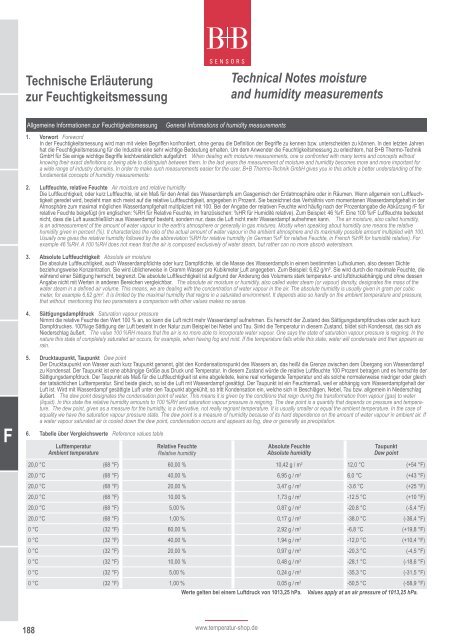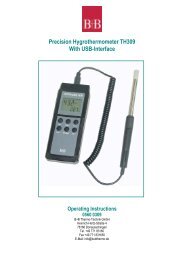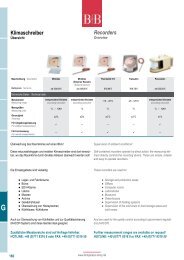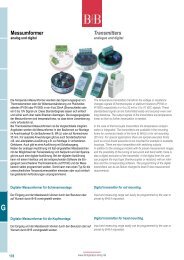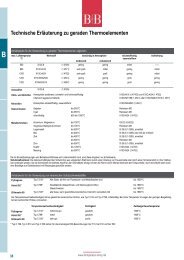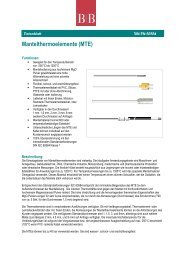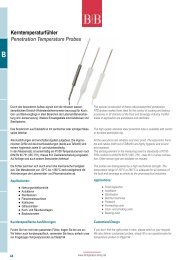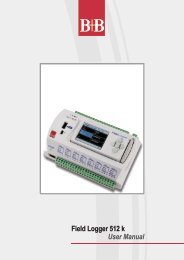B - Temperatur-Shop
B - Temperatur-Shop
B - Temperatur-Shop
You also want an ePaper? Increase the reach of your titles
YUMPU automatically turns print PDFs into web optimized ePapers that Google loves.
F<br />
Technische Erläuterung<br />
zur Feuchtigkeitsmessung<br />
Allgemeine Informationen zur Feuchtigkeitsmessung General Informations of humidity measurements<br />
188<br />
www.temperatur-shop.de<br />
Technical Notes moisture<br />
and humidity measurements<br />
1. Vorwort Foreword<br />
In der Feuchtigkeitsmessung wird man mit vielen Begriffen konfrontiert, ohne genau die Definition der Begriffe zu kennen bzw. unterscheiden zu können. In den letzten Jahren<br />
hat die Feuchtigkeitsmessung für die Industrie eine sehr wichtige Bedeutung erhalten. Um dem Anwender die Feuchtigkeitsmessung zu erleichtern, hat B+B Thermo-Technik<br />
GmbH für Sie einige wichtige Begriffe leichtverständlich aufgeführt: When dealing with moisture measurements, one is confronted with many terms and concepts without<br />
knowing their exact definitions or being able to distinguish between them. In the last years the measurement of moisture and humidity becomes more and more important for<br />
a wide range of industry domains. In order to make such measurements easier for the user, B+B Thermo-Technik GmbH gives you in this article a better understanding of the<br />
fundamental concepts of humidity measurements:<br />
2. Luftfeuchte, relative Feuchte Air moisture and relative humidity<br />
Die Luftfeuchtigkeit, oder kurz Luftfeuchte, ist ein Maß für den Anteil des Wasserdampfs am Gasgemisch der Erdatmosphäre oder in Räumen. Wenn allgemein von Luftfeuchtigkeit<br />
geredet wird, bezieht man sich meist auf die relative Luftfeuchtigkeit, angegeben in Prozent. Sie bezeichnet das Verhältnis vom momentanen Wasserdampfgehalt in der<br />
Atmosphäre zum maximal möglichen Wasserdampfgehalt multipliziert mit 100. Bei der Angabe der relativen Feuchte wird häufig nach der Prozentangabe die Abkürzung rF für<br />
relative Feuchte beigefügt (im englischen: %RH für Relative Feuchte, im französischen: %HR für Humidité relative). Zum Beispiel: 46 %rF. Eine 100 %rF Luftfeuchte bedeutet<br />
nicht, dass die Luft ausschließlich aus Wasserdampf besteht, sondern nur, dass die Luft nicht mehr Wasserdampf aufnehmen kann. The air moisture, also called humidity,<br />
is an admeasurement of the amount of water vapour in the earth’s atmosphere or generally in gas mixtures. Mostly when speaking about humidity one means the relative<br />
humidity given in percent (%). It characterizes the ratio of the actual amount of water vapour in the ambient atmosphere and its maximally possible amount multiplied with 100.<br />
Usually one gives the relative humidity followed by the abbreviation %RH for relative humidity (in German %rF for relative Feuchte, in French %HR for humidité relative). For<br />
example 46 %RH. A 100 %RH does not mean that the air is composed exclusively of water steam, but rather can no more absorb watersteam.<br />
3. Absolute Luftfeuchtigkeit Absolute air moisture<br />
Die absolute Luftfeuchtigkeit, auch Wasserdampfdichte oder kurz Dampfdichte, ist die Masse des Wasserdampfs in einem bestimmten Luftvolumen, also dessen Dichte<br />
beziehungsweise Konzentration. Sie wird üblicherweise in Gramm Wasser pro Kubikmeter Luft angegeben. Zum Beispiel: 6,62 g/m³. Sie wird durch die maximale Feuchte, die<br />
während einer Sättigung herrscht, begrenzt. Die absolute Luftfeuchtigkeit ist aufgrund der Änderung des Volumens stark temperatur- und luftdruckabhängig und ohne dessen<br />
Angabe nicht mit Werten in anderen Bereichen vergleichbar. The absolute air moisture or humidity, also called water steam (or vapour) density, designates the mass of the<br />
water steam in a defined air volume. This means, we are dealing with the concentration of water vapour in the air. The absolute humidity is usually given in gram per cubic<br />
meter, for example 6,62 g/m 3 . It is limited by the maximal humidity that reigns in a saturated environment. It depends also so hardly on the ambient temperature and pressure,<br />
that without mentioning this two parameters a comparison with other values makes no sense.<br />
4. Sättigungsdampfdruck Saturation vapour pressure<br />
Nimmt die relative Feuchte den Wert 100 % an, so kann die Luft nicht mehr Wasserdampf aufnehmen. Es herrscht der Zustand des Sättigungsdampfdruckes oder auch kurz<br />
Dampfdruckes. 100%ige Sättigung der Luft besteht in der Natur zum Beispiel bei Nebel und Tau. Sinkt die <strong>Temperatur</strong> in diesem Zustand, bildet sich Kondensat, das sich als<br />
Niederschlag äußert. The value 100 %RH means that the air is no more able to incorporate water vapour. One says the state of saturation vapour pressure is reigning. In the<br />
nature this state of completely saturated air occurs, for example, when having fog and mist. If the temperature falls while this state, water will condensate and then appears as<br />
rain.<br />
5. Drucktaupunkt, Taupunkt Dew point<br />
Der Drucktaupunkt von Wasser auch kurz Taupunkt genannt, gibt den Kondensationspunkt des Wassers an, das heißt die Grenze zwischen dem Übergang von Wasserdampf<br />
zu Kondensat. Der Taupunkt ist eine abhängige Größe aus Druck und <strong>Temperatur</strong>. In diesem Zustand würde die relative Luftfeuchte 100 Prozent betragen und es herrschte der<br />
Sättigungsdampfdruck. Der Taupunkt als Maß für die Luftfeuchtigkeit ist eine abgeleitete, keine real vorliegende <strong>Temperatur</strong> und als solche normalerweise niedriger oder gleich<br />
der tatsächlichen Lufttemperatur. Sind beide gleich, so ist die Luft mit Wasserdampf gesättigt. Der Taupunkt ist ein Feuchtemaß, weil er abhängig vom Wasserdampfgehalt der<br />
Luft ist. Wird mit Wasserdampf gesättigte Luft unter den Taupunkt abgekühlt, so tritt Kondensation ein, welche sich in Beschlägen, Nebel, Tau bzw. allgemein in Niederschlag<br />
äußert. The dew point designates the condensation point of water. This means it is given by the conditions that reign during the transformation from vapour (gas) to water<br />
(liquid). In this state the relative humidity amounts to 100 %RH and saturation vapour pressure is reigning. The dew point is a quantity that depends on pressure and temperature.<br />
The dew point, given as a measure for the humidity, is a derivative, not really regnant temperature. It is usually smaller or equal the ambient temperature. In the case of<br />
equality we have the saturation vapour pressure state. The dew point is a measure of humidity because of its hard dependence on the amount of water vapour in ambient air. If<br />
a water vapour saturated air is cooled down the dew point, condensation occurs and appears as fog, dew or generally as precipitation.<br />
6. Tabelle über Vergleichswerte Reference values table<br />
Lufttemperatur<br />
Ambient temperature<br />
Relative Feuchte<br />
Relative humidity<br />
Absolute Feuchte<br />
Absolute humidity<br />
Taupunkt<br />
Dew point<br />
20,0 °C (68 °F) 60,00 % 10,42 g / m 3 12,0 °C (+54 °F)<br />
20,0 °C (68 °F) 40,00 % 6,95 g / m 3 6,0 °C (+43 °F)<br />
20,0 °C (68 °F) 20,00 % 3,47 g / m 3 -3.6 °C (+25 °F)<br />
20,0 °C (68 °F) 10,00 % 1,73 g / m 3 -12.5 °C (+10 °F)<br />
20,0 °C (68 °F) 5,00 % 0,87 g / m 3 -20.8 °C (-5,4 °F)<br />
20,0 °C (68 °F) 1,00 % 0,17 g / m 3 -38.0 °C (-36,4 °F)<br />
0 °C (32 °F) 60,00 % 2,92 g / m 3 -6,8 °C (+19,8 °F)<br />
0 °C (32 °F) 40,00 % 1,94 g / m 3 -12,0 °C (+10,4 °F)<br />
0 °C (32 °F) 20,00 % 0,97 g / m 3 -20,3 °C (-4,5 °F)<br />
0 °C (32 °F) 10,00 % 0,48 g / m 3 -28,1 °C (-18,6 °F)<br />
0 °C (32 °F) 5,00 % 0,24 g / m 3 -35,3 °C (-31,5 °F)<br />
0 °C (32 °F) 1,00 % 0,05 g / m3 -50,5 °C (-58,9 °F)<br />
Werte gelten bei einem Luftdruck von 1013,25 hPa. Values apply at an air pressure of 1013,25 hPa.


